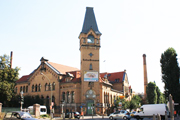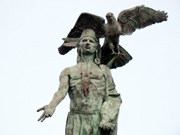New York owes a large fraction of its fascinating personality to its idiosyncratic urbanism. It was based on a medieval pattern, which had princes and paupers living not five feet from each other. As usual, this made for an interesting civilization.
Cities and neighborhoods made of similar houses full of similar people usually tend to promote distrust, fear and occasionally paranoia towards the outside world. New York was on its way to becoming the exact opposite of that.

The three most sordid houses where one could sublet a room in foundational New York were the Old Brewery (where the Coulter beer factory at Collect once stood), Gotham Court at Cherry Street (once home to George Washington as the first president of the country, it is now occupied by municipal buildings) and the Arch Block in Sullivan Street. In Water Street it wasn't rare to see dog vs. rat fights.
There was also a man who, by today's standards, worked in show business. His job consisted of biting the head off living rats in exchange for a couple of coins. Think about him when you next complain about your job.

Politics, as usual, would mainly revolve around two groups. There was Tammany Hall (comprised of future Democrats), which were hopelessly corrupt and owed their name to an ancient Indian chief -- Tammanend The Affable, leader of the Lenape Indians. And then there were the Know-Nothing (future Republicans), passionately anti-immigration and anti-Catholic. Which pretty much amounts to anti-Irish. Needless to say, Tammany Hall was led by an Irish man.
In 1855 there were up to thirty thousand members in each party. They were all profoundly devoted to corruption and electoral fraud.
The Know-Nothing's bellwether was a bare-knuckle boxer called William Poole (or Bill the Butcher as he would pass on to history, although the name is now more familiar to Americans for being that of a chain of butcher shops. America is puzzling like that sometimes). Tammany Hall, on the other hand, was led by William Boss Tweed, an Irish firefighter and politician. He would also pass on to the annals of history but for very different reasons.
Tweed has the distinction of creating the most effective political machine in U.S. history. He stole about $200 million from New York taxpayers between 1865 and 1871, rigged every election he was involved with, and he personally controlled the city's police. (Which partially explains the city's long-standing Irish cop image.)
To administer the police, he applied free market logic: In order to move up from Deputy to Sergeant, all you had to do was pay him $1,600. For a promotion from Sergeant to Captain, the fee was to the order of $12,000. And so on. The agent would then recover his investment through extortion and protection rackets. It was a lucrative career.
The Tammany more or less governed New York City until 1934, when Fiorello LaGuardia became mayor and set up a relatively clean and modern mayoralty. This was unprecedented in New York and prompted the arrival of a new era in local politics. Many of the Tammanies moved on to more refined mobster gangs, which, up until 2011, were a big part of the City's tradition.
"Tammany" is now a pejorative word. But they have to be commended for their task. After all, there was no public administration -- because the richest New Yorkers (rich, native, elitist and anti-immigrant) refused to help finance it. So it was Boss Tweed's impudence what opened the city's doors to countless immigrants who would arrive to Ellis Island with nothing more than a handkerchief, some lice and plenty of hope.
And that made New York City the kind of special town it is today -- the only financial and cultural capital of a country that does not have the country's more prestigious dialect.